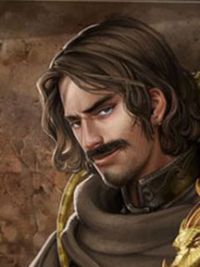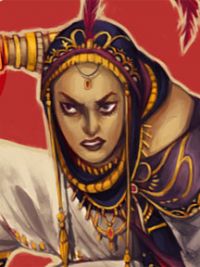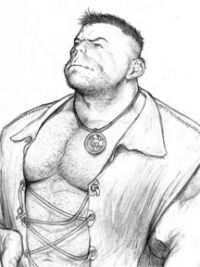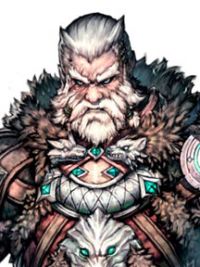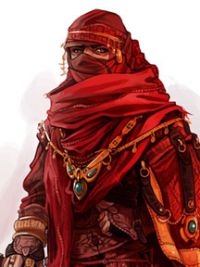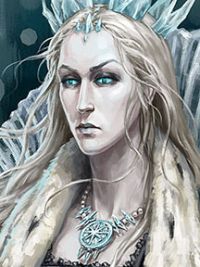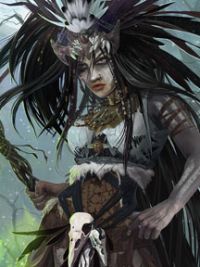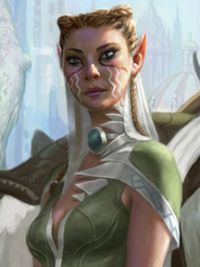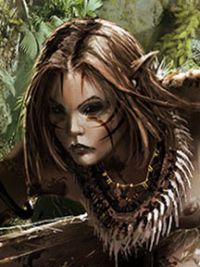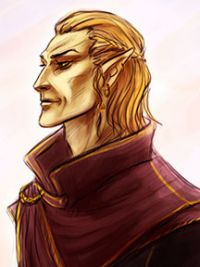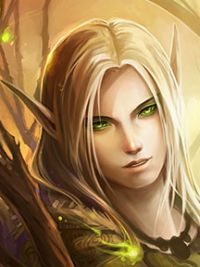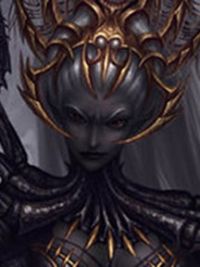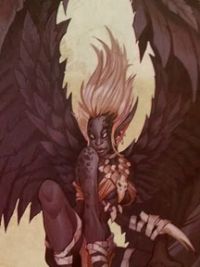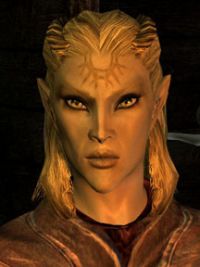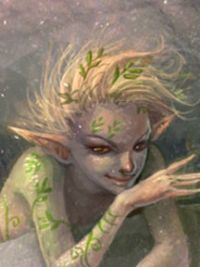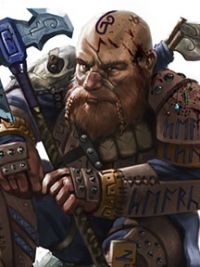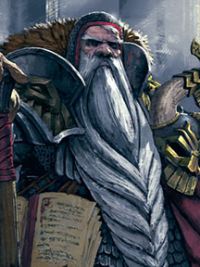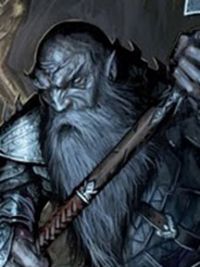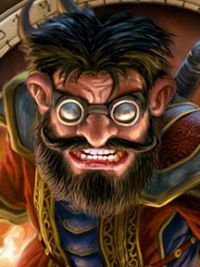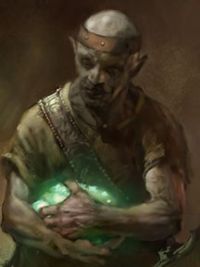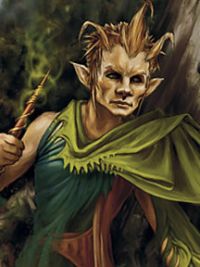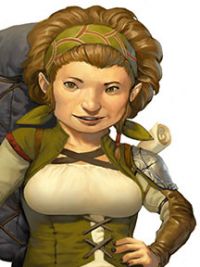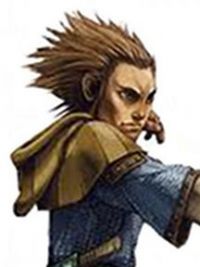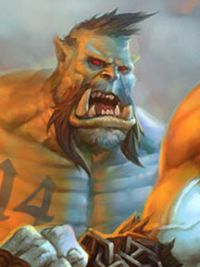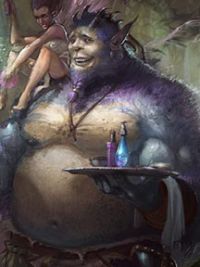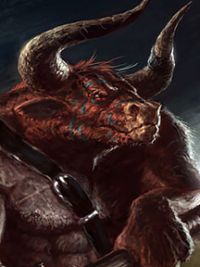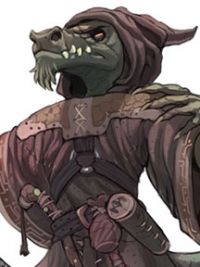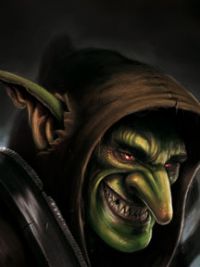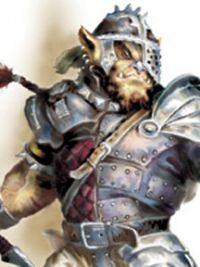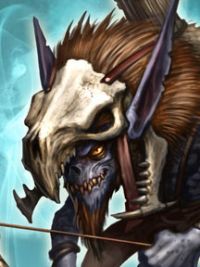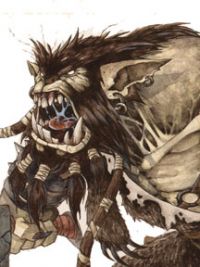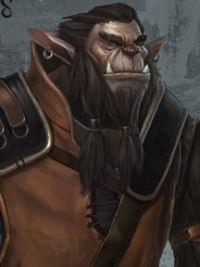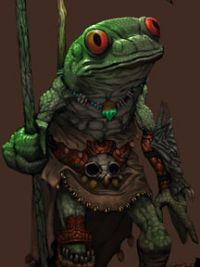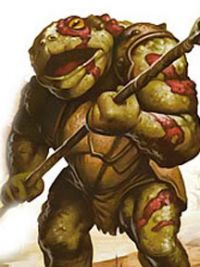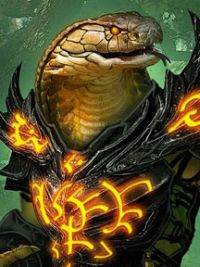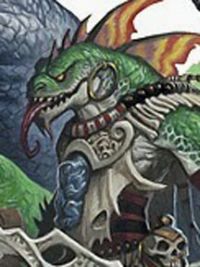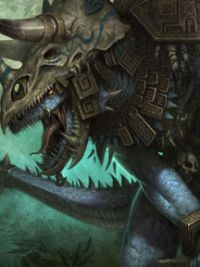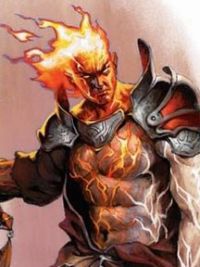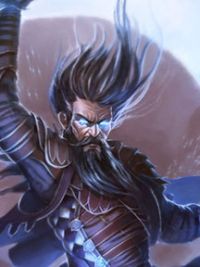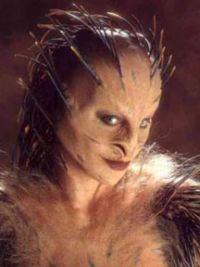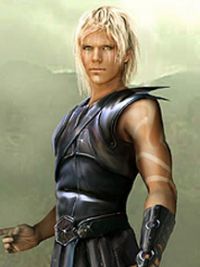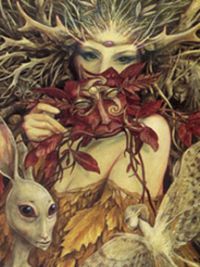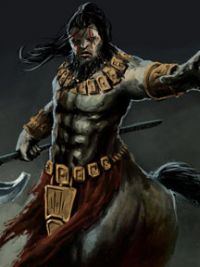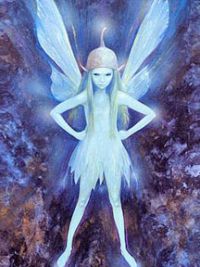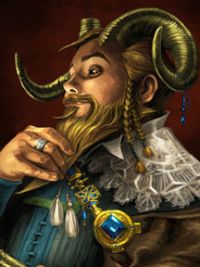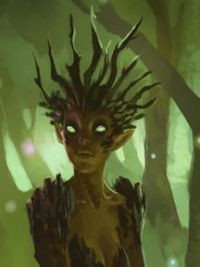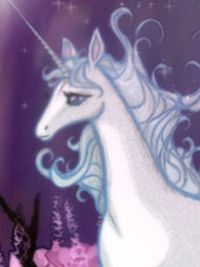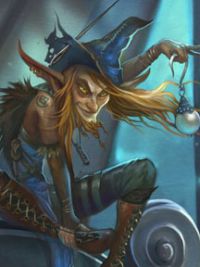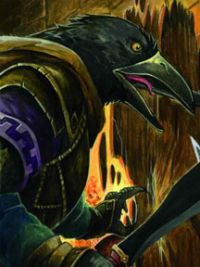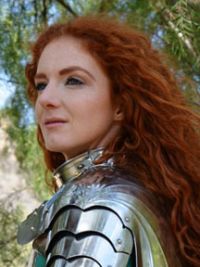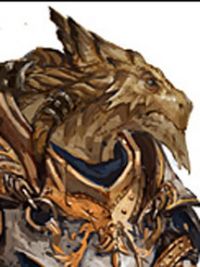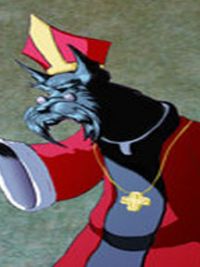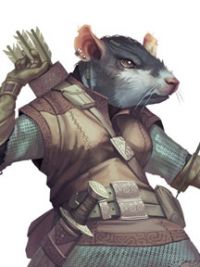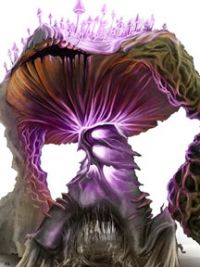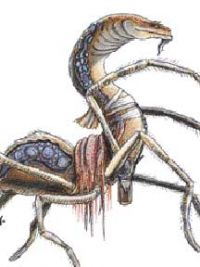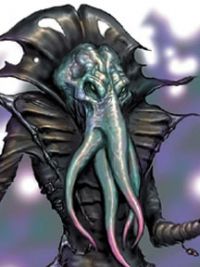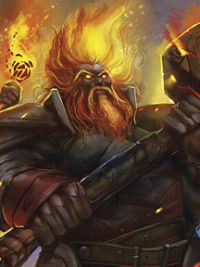Difference between revisions of "Races of Calador"
| Line 17: | Line 17: | ||
<br>• The people of Darshiniath speak the Darshinian language. They typically learn the languages of other peoples they deal with as well, including obscure ones.<br> | <br>• The people of Darshiniath speak the Darshinian language. They typically learn the languages of other peoples they deal with as well, including obscure ones.<br> | ||
|- | |- | ||
| − | | [[Image:yb_hoventi.jpg|left|200px|Human, Hoventi]] || '''Hoventi'''<br> The Hoventi are the half-orcs of Salista Hoventesh & Krive Del, though the term has come to be used for all half-orcs, which have become relatively common in many parts of Manix.<br> | + | | [[Image:yb_hoventi.jpg|left|200px|Human, Hoventi]] || '''Hoventi'''<br> The Hoventi or more commonly just "hoven" are the half-orcs of Salista Hoventesh & Krive Del, though the term has come to be used for all half-orcs, which have become relatively common in many parts of Manix.<br> |
'''Religion:''' Words go here.<br> | '''Religion:''' Words go here.<br> | ||
'''Traits & Adjustments:''' See entry for Half-Orc in the Players Handbook.<br> | '''Traits & Adjustments:''' See entry for Half-Orc in the Players Handbook.<br> | ||
| − | '''Languages:''' You can speak, read, and write Orbaan and one extra language of your choice. | + | '''Languages:''' You can speak, read, and write Orbaan or Threxantran and one extra language of your choice. |
|- | |- | ||
| [[Image:yb_nothgar.jpg|left|200px|Human, Nothgar]] || '''Nothgar'''<br> The Nothgar are rugged mountain barbarians that live in the cold tundra and mountains of Noth. Nothgar have giant blood in their veins and are considerably taller, broader and more heavily muscled than a typical human. Nothgar also have longer livespans that other humans and may live to 120, maintaining their good health and vitality for a long time, though very few die of old age. The nothgar typically have light or pale skin and hair that ranges from blond or ginger to brown to black. Despite the cold of their homeland, the nothgar are often only lightly clad, exposing skin which is frequently elaborately tattooed. | | [[Image:yb_nothgar.jpg|left|200px|Human, Nothgar]] || '''Nothgar'''<br> The Nothgar are rugged mountain barbarians that live in the cold tundra and mountains of Noth. Nothgar have giant blood in their veins and are considerably taller, broader and more heavily muscled than a typical human. Nothgar also have longer livespans that other humans and may live to 120, maintaining their good health and vitality for a long time, though very few die of old age. The nothgar typically have light or pale skin and hair that ranges from blond or ginger to brown to black. Despite the cold of their homeland, the nothgar are often only lightly clad, exposing skin which is frequently elaborately tattooed. | ||
| Line 73: | Line 73: | ||
• The scindo speak the language most common to the region they come from; Krive Del speak Krom, Salista Hoventesh speak Orbaan, those in Threxen populated regions speak Threxantran or Goltiri if they live amongst the dwarves and gnomes of Nakaltia, etc. They typically learn the languages of other peoples they deal with as well, including obscure languages. Like the Threxen, they are fond of sprinkling their speec with words borrowed from other tongues: orcish curses, hobbit innuendo, Darshinian poetry, and so on. | • The scindo speak the language most common to the region they come from; Krive Del speak Krom, Salista Hoventesh speak Orbaan, those in Threxen populated regions speak Threxantran or Goltiri if they live amongst the dwarves and gnomes of Nakaltia, etc. They typically learn the languages of other peoples they deal with as well, including obscure languages. Like the Threxen, they are fond of sprinkling their speec with words borrowed from other tongues: orcish curses, hobbit innuendo, Darshinian poetry, and so on. | ||
|- | |- | ||
| − | | [[Image:yb_asana.jpg|left|200px|Elf, Asana]] || '''Asana'''<br> | + | | [[Image:yb_asana.jpg|left|200px|Elf, Asana]] || '''Asana'''<br> Also known as star elves, the asana are claimed by neither the Ilfyd elves (misanta, sethi, etc) nor the Ydis elves (scindo & fei). They claim to be fae blooded creatures that share both elven and human ancestry. The asana have no homeland that they call their own and generally live amongst humans. Historically the asana were closely associated with the hiklos and this stigma follows them to this day. The asana do not enter trance states when they rest like other elves, in fact they are renown for their love of sleep and dreaming, often giving them a reputation of being lazy to other races.<br> |
'''Religion:''' Words go here.<br> | '''Religion:''' Words go here.<br> | ||
| − | '''Traits & Adjustments:''' | + | '''Traits & Adjustments:''' See entry for Elf in the Players Handbook. The Asana do not possess the elven 'Trance' trait. Increase Intelligence by +1 and gain the 'Fey Step' and 'Cantrip' traits listed below.<br> |
| + | • '''Fey Step:''' You can cast the misty step spell once using this trait. You regain the ability to do so when you finish a short or long rest.<br> | ||
| + | • '''Cantrip:''' You know one cantrip of your choice from the wizard spell list. Intelligence is your spellcasting ability for it..<br> | ||
'''Languages:''' You can speak, read, and write any two languages of your choice. | '''Languages:''' You can speak, read, and write any two languages of your choice. | ||
|- | |- | ||
| Line 89: | Line 91: | ||
'''Languages:''' You can speak, read, and write Huldra and one extra language of your choice. | '''Languages:''' You can speak, read, and write Huldra and one extra language of your choice. | ||
|- | |- | ||
| − | | [[Image:yb_besarian.jpg|left|200px|Elf, Besarian]] || '''Besarian'''<br> The avariel | + | | [[Image:yb_besarian.jpg|left|200px|Elf, Besarian]] || '''Besarian'''<br> The avariel and the stryx - the winged elves of Misanta and the harpies of Kardos.<br> |
'''Religion:''' Words go here.<br> | '''Religion:''' Words go here.<br> | ||
'''Traits & Adjustments:''' Pending.<br> | '''Traits & Adjustments:''' Pending.<br> | ||
| Line 142: | Line 144: | ||
'''Traits & Adjustments:''' See entry for Gnome and Rock Gnome in the Players Handbook.<br> | '''Traits & Adjustments:''' See entry for Gnome and Rock Gnome in the Players Handbook.<br> | ||
'''Languages:''' You can speak, read and write Nokol and one extra language of your choice. Gnomes of Nakaltia can choose to substitute Goltiri in place of Nokol. | '''Languages:''' You can speak, read and write Nokol and one extra language of your choice. Gnomes of Nakaltia can choose to substitute Goltiri in place of Nokol. | ||
| − | • Nokol is the native gnomish language, though since the destruction of the gnomish homeland of Northoll, use of the language is in decline as an increasing number of the gnomes that fled to Nakaltia have converted to the use of Goltiri. Nokol is still commonly spoken amongst the gnomes of Striker in Tranzconox, though most of them are also fluent in Conox, which is the dominant language spoken by most of their non-gnomish constituents and neighbors.<br> | + | <br>• Nokol is the native gnomish language, though since the destruction of the gnomish homeland of Northoll, use of the language is in decline as an increasing number of the gnomes that fled to Nakaltia have converted to the use of Goltiri. Nokol is still commonly spoken amongst the gnomes of Striker in Tranzconox, though most of them are also fluent in Conox, which is the dominant language spoken by most of their non-gnomish constituents and neighbors.<br> |
|- | |- | ||
| [[Image:yb_svirfneblin.jpg|left|200px|Gnome, Svirfneblin]] || '''Svirfneblin'''<br>Deep gnomes of the Underdark.<br> | | [[Image:yb_svirfneblin.jpg|left|200px|Gnome, Svirfneblin]] || '''Svirfneblin'''<br>Deep gnomes of the Underdark.<br> | ||
| Line 165: | Line 167: | ||
'''Languages:''' You can speak, read, and write either Laeo or Threxantran and one extra language of your choice (which may be the other one if chosen). | '''Languages:''' You can speak, read, and write either Laeo or Threxantran and one extra language of your choice (which may be the other one if chosen). | ||
|- | |- | ||
| − | | [[Image:yb_ilian.jpg|left|200px|Ilian]] || '''Ilian'''<br>The ilian of Valexys are descendants of a race called the kender from another world that became stranded when their strange magical ship crash landed in Valexys.<br> | + | | [[Image:yb_ilian.jpg|left|200px|Ilian]] || '''Ilian'''<br>The ilian of Valexys are descendants of a race called the kender from another world that became stranded when their strange magical ship crash landed in Valexys. Initially mistaken as some sort of hobbits, neighbors were quick to shun them in fear of becoming associated with the doomed species and drawing the attention of the mad Archmage Katrina who had nearly wiped the hobbit race and those who had provided them succor from the land.<br> |
| + | The stranded little folk established a new home and eventually a new culture and identity for themselves, as their old ways were not conducive to the self sufficiency necessary to survive as a species. They modeled themselves after the hobbits of the old world, having inherited those lands as their own and they called themselves the ilian, a Laeo word meaning to be reborn (though technically it translates literally to "twice-baked" in reference to a baking method).<br> | ||
'''Religion:''' Words go here.<br> | '''Religion:''' Words go here.<br> | ||
'''Traits & Adjustments:''' See entry for Halfling and Lightfoot in the Players Handbook.<br> | '''Traits & Adjustments:''' See entry for Halfling and Lightfoot in the Players Handbook.<br> | ||
| Line 177: | Line 180: | ||
{| align="center" border="1" style="background: white" | {| align="center" border="1" style="background: white" | ||
| [[Image:yb_orc.jpg|left|200px|Orc, Hoven]] || '''Orc'''<br>The orcs of Salista Hoventesh are half a head taller than a human and have twice the body weight made entirely of muscle They have beady red or yellow eyes and their skin ranges from blue or green to grey with hair that is usually grey, brown or black. They have massive jaws revealing pointed teeth, dominated by large lower canines that jut up from their under-bite. They respect power and strength, and naturally tend towards becoming bigger and stronger as they rise through their society. While they lack the education of more advanced races, orcs possess immense cunning and are quick learners, but rarely adopt new tactics to replace their fondness for close quarters brutality. | | [[Image:yb_orc.jpg|left|200px|Orc, Hoven]] || '''Orc'''<br>The orcs of Salista Hoventesh are half a head taller than a human and have twice the body weight made entirely of muscle They have beady red or yellow eyes and their skin ranges from blue or green to grey with hair that is usually grey, brown or black. They have massive jaws revealing pointed teeth, dominated by large lower canines that jut up from their under-bite. They respect power and strength, and naturally tend towards becoming bigger and stronger as they rise through their society. While they lack the education of more advanced races, orcs possess immense cunning and are quick learners, but rarely adopt new tactics to replace their fondness for close quarters brutality. | ||
| − | The orcs of Salista Hoventesh are divided into numerous | + | The orcs of Salista Hoventesh are divided into numerous clans that are often at war amongst themselves, though the northern clans have mostly united under Clan Holuk in order to present a stronger unified front against their neighbors in Krive-Del. Gnolls, bugbears, scindo and hoven are commonplace amidst orc clans, as well as human and goblin slaves. While most orcs continue to live nomadic lifestyles, hunting and raiding to survive, many have begun to develop symbiotic relationships with hoven towns and villages that they encourage to develop within their territories. This change is often attributed to guidance from the scindo, who frequently act as advisers and chancellors for orc leaders and hold various other positions of power and influence in regards to leadership and commerce. |
| − | Orc culture is dominated by the concept of strength. The strongest and meanest orc is the leader until a stronger orc comes along. Amongst the nomadic | + | Orc culture is dominated by the concept of strength. The strongest and meanest orc is the leader until a stronger orc comes along. Amongst most of the nomadic clans, there are few laws, and therefore not much in the way of what would be considered crime. If an orc feels wronged, he can challenge the source of his grievance to a pit fight. Once the fight is over, the matter is considered settled. Orc clans generally have no concept of pity; to an orc, the weak are simply weak, and are beneath them in society. An orc attains a higher social rank by fighting and defeating members of that rank. |
<br> | <br> | ||
| − | '''Religion:''' The orcs of Salista Hoventesh worship Gruumsh and the other gods of the orcish pantheon.<br> | + | '''Religion:''' The orcs of Salista Hoventesh worship Gruumsh and the other gods of the orcish pantheon, though Clan Holuk seeks to spread the faith of the Dom Church which has been met with very mixed reactions.<br> |
'''Traits & Adjustments:''' Pending.<br> | '''Traits & Adjustments:''' Pending.<br> | ||
'''Languages:''' You can speak, read, and write Orbaan and one extra language of your choice. | '''Languages:''' You can speak, read, and write Orbaan and one extra language of your choice. | ||
| Line 298: | Line 301: | ||
{| align="center" border="1" style="background: white" | {| align="center" border="1" style="background: white" | ||
| − | | [[Image:yb_cathian.jpg|left|200px|Cathian, Kyanna]] || '''Cathian'''<br> | + | | [[Image:yb_cathian.jpg|left|200px|Cathian, Kyanna]] || '''Cathian'''<br>Cathians are an anthropomorphic species of humanoids that had been created through the Archmage Katrina Moonsinger's magical experiments on captive humans and hobbits in her "Genesis Chamber" deep below the Azure Academy of Katrica. Following their creation she released them into the world and having lost interest in the project ignored them. <br> |
| + | The cathian struggled to find their place in the world. The memories of the first cathian, who had all been people with lives and histories, had been erased, so they had no where to go. They lived in the forests of Katrica for a time, though neither the Katrican nationalists, nor the elves or fae of the forest accepted them - seeing them instead as monsters. It wasn't until two of their kind had risen to fame that they had started to find some sort of acceptance in the world; the Archdruid Kyanna, whom the feline cathian named themselves and Nezorah, a knight of Daltes, who inspired the canine cathians to likewise adopt as their name. There is also the less common rodent sub-species that called themselves the Slyth after their own lesser known hero, a rogue who supposedly stole the Obsidian Raven and the massive reptilian Slekoth which were more or less adopted as a cousin race of the saleer and are not generally recognized as cathian.<br> | ||
| + | Most of the cathian eventually moved on and found their way to Valexys and settled there alongside the ilian, another race that had sprung from nowhere and found itself in a world that did not want it. | ||
<br> | <br> | ||
'''Religion:''' Words go here.<br> | '''Religion:''' Words go here.<br> | ||
| − | '''Traits & Adjustments:''' | + | '''Traits & Adjustments:''' Choose between Kyanna (feline), Nezorah (canine) and Slyth (rodent) sub-species. Choose whether or not you are a medium or small sized variant.<br> |
| + | For medium sized cathian, see the entry for Human in the Players Handbook. You may choose to either use the standard Ability Score Increase or the Variant Human Trait. For small sized cathian, see the entry for Halfling and Lightfoot in the Players Handbook. In addition, you always have advantage on social rolls dealing with animals of your sub-species type.<br> | ||
'''Languages:''' You can speak, read, and write Laeo and one extra language of your choice. | '''Languages:''' You can speak, read, and write Laeo and one extra language of your choice. | ||
|- | |- | ||
| Line 310: | Line 316: | ||
{| align="center" border="1" style="background: white" | {| align="center" border="1" style="background: white" | ||
| − | | [[Image:yb_froglok.jpg|left|200px|Guktan]] || '''Guktan'''<br> | + | | [[Image:yb_froglok.jpg|left|200px|Guktan]] || '''Guktan'''<br>The guktan are descendants of the amphibian froklok race that had come from Norrath and with an appearance akin to 3-4' tall hunched over bipedal tree-frogs. <br>When the spires connecting Manix and Norrath were destroyed, they found themselves stranded on Manix. Most of their kind relocated to the swamps of northern Dontholl Mex and settled in small villages, most notably Marr's Light and New Guk. The guktan were immediately met with hostility from their neighboring bullywugs, which considered them weak and inferior creatures, only good for slave labor and consumption. The guktan have been warring with the larger amphibian race ever since while having the threat of the Blight and the Cult of the Gnarl slowly creeping up behind them in the east.. |
<br> | <br> | ||
| − | '''Religion:''' | + | '''Religion:''' The patron deity of the guktan, as he had been in their ancient homeland, is Mithaniel Marr.<br> |
'''Traits & Adjustments:''' Pending.<br> | '''Traits & Adjustments:''' Pending.<br> | ||
'''Languages:''' You can speak, read, and write Thollir and one extra language of your choice. | '''Languages:''' You can speak, read, and write Thollir and one extra language of your choice. | ||
| Line 328: | Line 334: | ||
{| align="center" border="1" style="background: white" | {| align="center" border="1" style="background: white" | ||
| − | | [[Image:yb_shissar.jpg|left|200px|Shissar]] || '''Shissar'''<br> | + | | [[Image:yb_shissar.jpg|left|200px|Shissar]] || '''Shissar'''<br>Yuan-ti. |
<br> | <br> | ||
'''Religion:''' Words go here.<br> | '''Religion:''' Words go here.<br> | ||
| Line 346: | Line 352: | ||
'''Languages:''' You can speak, read, and write Shissar and one extra language of your choice. | '''Languages:''' You can speak, read, and write Shissar and one extra language of your choice. | ||
|- | |- | ||
| − | | [[Image:yb_slekoth.jpg|left|200px|Slekoth]] || '''Slekoth'''<br>And their bigger, meaner cousins. | + | | [[Image:yb_slekoth.jpg|left|200px|Slekoth]] || '''Slekoth'''<br>And their bigger, meaner cousins. The slekoth were actually created by the Archmage Katrina Moonsinger as part of her cathian experiments, though when she abandoned them in the wild, the saleer had taken them in as some of their own. |
<br> | <br> | ||
'''Religion:''' Words go here.<br> | '''Religion:''' Words go here.<br> | ||
| Line 358: | Line 364: | ||
{| align="center" border="1" style="background: white" | {| align="center" border="1" style="background: white" | ||
| − | | [[Image:yb_genasi.jpg|left|200px|Genasi]] || '''Genasi'''<br> | + | | [[Image:yb_genasi.jpg|left|200px|Genasi]] || '''Genasi'''<br> The genasi are human-derived planetouched infused with the power of the elementals, most often as the result of crossbreeding between humans and the powerful genie races or other elementals native to the elemental planes. Genasi are a varied race with abilities relative to their particular elemental lineage and experiences. Genasi are rare in general, but most commonly found in Darshiniath. |
<br> | <br> | ||
'''Religion:''' Words go here.<br> | '''Religion:''' Words go here.<br> | ||
'''Traits & Adjustments:''' Pending.<br> | '''Traits & Adjustments:''' Pending.<br> | ||
| − | '''Languages:''' You can speak, read, and write any two languages of your choice. | + | '''Languages:''' You can speak, read, and write any two languages of your choice (including character creation access to the elemental languages). |
|- | |- | ||
| [[Image:yb_cansin.jpg|left|200px|Cansin]] || '''Cansin'''<br>Chaos planetouched. | | [[Image:yb_cansin.jpg|left|200px|Cansin]] || '''Cansin'''<br>Chaos planetouched. | ||
| Line 370: | Line 376: | ||
'''Languages:''' You can speak, read, and write any two languages of your choice. | '''Languages:''' You can speak, read, and write any two languages of your choice. | ||
|- | |- | ||
| − | | [[Image:yb_tiefling.jpg|left|200px|Tiefling]] || '''Tiefling'''<br>Infernal and/or Abyssal | + | | [[Image:yb_tiefling.jpg|left|200px|Tiefling]] || '''Tiefling'''<br>Tieflings are human-based planetouched, native outsiders that are infused with the touch of the Infernal and/or Abyssal planes, most often through descent from fiends — demons, devils, evil deities, and others who have bred with humans. Tieflings are known for their cunning and personal allure, which makes them excellent deceivers as well as inspiring leaders when prejudices are laid aside.<br> |
| + | Although their evil ancestors may be many generations removed, the taint lingers. Unlike half-fiends, tieflings are not predisposed to evil alignments and vary in alignment nearly as widely as full humans, though tieflings are certainly devious.<br> | ||
| + | Tieflings tend to have an unsettling air about them, and most people are uncomfortable around them, whether they are aware of the tiefling's unsavory ancestry or not. While some look like normal humans, most retain physical characteristics derived from their ancestor, with the most common such features being horns, non-prehensile tails, and pointed teeth. Some tieflings also have eyes that are solid orbs of black, red, white, silver, or gold, while others have eyes more similar to those of humans. Other, more unusual characteristics include a sulfurous odor, cloven feet, or a general aura of discomfort they leave on others.<br> | ||
| + | In many other ways tieflings are similar to humans physically. Tieflings are, on average, just as tall as humans, from 5'6" to 6'2" and weigh just a little bit heavier at 140 to 220 lbs. Tiefling skin is usually human-like in color, though extending past normal human colors into other hues as well. Tiefling hair is often the same color as human hair as well, though dark blue, red, or purple are also common shades among the race. Although it is not always the case, tieflings tend to have better reflexes than their human kin. This, along with their natural propensity for hiding and deceit helps to give tieflings a reputation for thievery and duplicity.<br> | ||
| + | Tieflings who have striking inhuman features are often killed at birth by their horrified parent or others. Only those tieflings with subdued features or born to someone indifferent to their appearance, either out of acceptance or cruel purpose, are likely to reach adulthood. Those tieflings who do reach adulthood can be expected to age at roughly the same rate. They also live for about the same amount of time. | ||
<br> | <br> | ||
'''Religion:''' Words go here.<br> | '''Religion:''' Words go here.<br> | ||
| − | '''Traits & Adjustments:''' | + | '''Traits & Adjustments:''' See entry for Tiefling in the Players Handbook.<br> |
| − | '''Languages:''' You can speak, read, and write any two languages of your choice. | + | '''Languages:''' You can speak, read, and write any two languages of your choice (including character creation access to both Infernal and Abyssal. |
|- | |- | ||
| − | | [[Image:yb_aasimar.jpg|left|200px|Aasimar]] || '''Aasimar'''<br> | + | | [[Image:yb_aasimar.jpg|left|200px|Aasimar]] || '''Aasimar'''<br>Aasimar are human-based planetouched, native outsiders that had in their blood some good, otherworldly characteristics. They were often, but not always, descended from angels and other creatures of pure good alignment, but while predisposed to good alignments, aasimar were by no means always good.<br> |
| + | Aasimar bore the mark of their celestial touch through many different physical features that often varied from individual to individual. Most commonly, aasimar were very similar to humans, like tieflings and other planetouched. Nearly all aasimar were uncommonly beautiful and still, and they were often significantly taller than humans as well.<br> | ||
| + | While several aasimar were immediately identifiable as such, others were even less distinguishable than tieflings from their human ancestors, commonly standing out with only one unusual feature. Most aasimar had pupil-less pale white, gray, or golden eyes or silver hair, but those descended from planetars could also have emerald skin, while those descended from avoral celestials might have feathers mixed in with their hair. Those descended from ghaeles often had pearly opalescent eyes. Solar-descended aasimars often had brilliant topaz eyes instead or silvery or golden skin and devas with couatl or lillend lineage most commonly had small, iridescent scales. Many aasimar also had a light covering of feathers on their shoulders, where an angel's wings might sprout. As in tieflings, aasimar bloodlines could sometimes run dormant for generations, reemerging after being hidden for some time. | ||
<br> | <br> | ||
'''Religion:''' Words go here.<br> | '''Religion:''' Words go here.<br> | ||
| − | '''Traits & Adjustments:''' | + | '''Traits & Adjustments:''' See entry for Aasimar in the Dungeon Masters Guide.<br> |
| − | '''Languages:''' You can speak, read, and write any two languages of your choice. | + | '''Languages:''' You can speak, read, and write any two languages of your choice including character creation access to the Celestial language). |
|- | |- | ||
|} | |} | ||
| Line 436: | Line 448: | ||
{| align="center" border="1" style="background: white" | {| align="center" border="1" style="background: white" | ||
| − | | [[Image:yb_tengu.jpg|left|200px|Tengu]] || '''Tengu'''<br>Birdmen. | + | | [[Image:yb_tengu.jpg|left|200px|Tengu]] || '''Tengu'''<br>Birdmen (kenku). |
<br> | <br> | ||
'''Religion:''' Words go here.<br> | '''Religion:''' Words go here.<br> | ||
| Line 463: | Line 475: | ||
<br> | <br> | ||
'''Religion:''' Words go here.<br> | '''Religion:''' Words go here.<br> | ||
| − | '''Traits & Adjustments:''' | + | '''Traits & Adjustments:''' See entry for Dragonborn in the Players Handbook.<br> |
| − | '''Languages:''' You can speak, read, and write | + | '''Languages:''' You can speak, read, and write Raandracoi and one extra language of your choice. |
|- | |- | ||
|} | |} | ||
| Line 472: | Line 484: | ||
{| align="center" border="1" style="background: white" | {| align="center" border="1" style="background: white" | ||
| − | | [[Image:yb_rofka.jpg|left|200px|Rofka]] || '''Rofka'''<br>Dwarf-proportioned | + | | [[Image:yb_rofka.jpg|left|200px|Rofka]] || '''Rofka'''<br>Dwarf-proportioned Scottish terrier people. |
<br> | <br> | ||
'''Religion:''' Words go here.<br> | '''Religion:''' Words go here.<br> | ||
| Line 484: | Line 496: | ||
{| align="center" border="1" style="background: white" | {| align="center" border="1" style="background: white" | ||
| − | | [[Image:yb_nezumi.jpg|left|200px|Nezumi]] || '''Nezumi'''<br> | + | | [[Image:yb_nezumi.jpg|left|200px|Nezumi]] || '''Nezumi'''<br>Gnome-sized mouselike people that dwell in the region called the Nulldark at the center of the world. |
<br> | <br> | ||
'''Religion:''' Words go here.<br> | '''Religion:''' Words go here.<br> | ||
Revision as of 15:47, 6 February 2015
Contents
- 1 Humans
- 2 Elves
- 3 Dwarves
- 4 Gnomes
- 5 Laeo
- 6 Orcs
- 7 Ogres
- 8 Minotaurs
- 9 Gnolls
- 10 Kobolds
- 11 Goblins
- 12 Bugbears
- 13 Cathian
- 14 Guktan and Bullywugs
- 15 Shissar
- 16 Saleer
- 17 Planetouched
- 18 Sylvan and Fae
- 19 Tengu
- 20 Doppelganger
- 21 BalGez-I'ir
- 22 Rofka
- 23 Nezumi
- 24 Thri-kreen
- 25 Myconid
- 26 Neogi
- 27 Illithid
- 28 Giants
Humans
| Threxen The Threxen people are the most populous of the human bloodlines in Threxantra. They are descended from the ancient Carlitia, Thissia and Thexdoni people, once separated by oceans before their lands had been merged together through arcane means to form what is now Threxantra. Threxen people can stand from 5' to a little over 6' tall and weigh from 125 to 250 pounds. Skin shades range from olive to pale and hair color from black to blond (curly, kinky, or straight). Threxen garb and grooming varies by region. Daltes men wear kilts and trousers with tunics and flat caps and bonnets and prefer groomed beards or mustaches and short hair and women grow their hair long and wear long skirts and sashes, often leaving one breast bared. In Talaria men generally wear pants, coats and hats with wide brims and/or tall crowns, have shoulder length hair and shave or have sculpted mustaches and goatees. The women wear long dresses that offer more modesty than their Daltes neighbors. In Estland, fashion changes often and holds a much more important role in their society, especially amongst the nobility, but the more rich, intricate and extravagant their appearance and garb is, the more impressive they are viewed by their peers. | |
| Darshinian The people of the distant tropical continent of Darshiniath were the first people to build crafts capable of long sea voyages. They had discovered Threxantra long ago and established a settlement in what is now Zalcoryn. Their ships are often called "water palaces" by others due to their massive size and ability to carry a great many passengers and cargo. The Darshinian highly value art, music, exploration, trade and commerce and their people have spread throughout the world. Darshinian mages tend to specialize in illusion or elemental magic. Their cities are walled labyrinthine structures, each with a massive ziggurat at its heart where the priests live and the gods are worshiped. All of Darshiniath is ruled by a man chosen by Zeus and a woman chosen by Athena and they are attended and advised by priests representing each town and city in the land. Those other provinces are governed by their priests.
Darshinians have dusky olive to brown skin with bright almond shaped eyes of yellow, blue or green and dark hair. Men and women dress in a similar fashion, preferring long and flowing robes and layered clothing of colorful gossamer and silk and fez hats. Men and women generally grow their hair (and beards) long and will often wear it in one or many braids with an assortment of ornamentation, including ribbons, charms and bells (save for the clergy who shave their heads). The use of cosmetics, scented oils and perfumes is equally popular amongst both sexes. | |
| Hoventi The Hoventi or more commonly just "hoven" are the half-orcs of Salista Hoventesh & Krive Del, though the term has come to be used for all half-orcs, which have become relatively common in many parts of Manix. Religion: Words go here. | |
| Nothgar The Nothgar are rugged mountain barbarians that live in the cold tundra and mountains of Noth. Nothgar have giant blood in their veins and are considerably taller, broader and more heavily muscled than a typical human. Nothgar also have longer livespans that other humans and may live to 120, maintaining their good health and vitality for a long time, though very few die of old age. The nothgar typically have light or pale skin and hair that ranges from blond or ginger to brown to black. Despite the cold of their homeland, the nothgar are often only lightly clad, exposing skin which is frequently elaborately tattooed. Nothgar culture is highly individualistic with a focus on personal success and glory, which as a whole brings glory to their people as a whole, thus they seek to accomplish adventures or mighty feats in order to prove themselves, to build their legend through valor and great victories. Every nothgar hopes their tales will be told by skalds and celebrated amongst their people with story and song.
The nothgar have a great sense of personal honor, for an individual without respect from others is already forgotten, a fate far worse than any death. For many nothgar, the focus on prestige means they are willing to accept any challenge in order to prove their worth, though for some the pursuit of prestige translates to bragging, bullying, unwise decisions and an unwillingness to listen to reason. The nothgar are a hearty, proud people - quick to anger but then quick to forgive. They respect those who can best them in a fight so brawling is common. The nothgar proudly trace their worthy ancestors through many generations and often pass a common name through a family, but ancestry and family connections do not grant automatic respect. Everyone is judged not by their lineage or associated group but by what deeds they have done.
Religion: The nothgar worship totemic spirits of the natural world and totems of idealic concepts. | |
| Conox The Conox are humans that are native to the harsh deserts of Tranzconox. Religion: Words go here. | |
| Arrisian The people of Arris are taller and more slender than most humans with pale skin, eyes and hair and lean towards androgyny. The Arrisians are descended from the scholars, intellectuals and spellcasters that had followed Sirra GoldenStar to her magically created continent in order to create a erudite utopia. Before the events of Anaya's Folly, the use of magic existed in every aspect of Arrisian culture and lifestyle. Magic was used by cooks, tailors, coach drivers, guards, politicians, even children who began receiving instruction in the use of magic as early as they were able to learn to read. The people lived in an impossibly tall city crafted through magic that was protected from the icy cold of the land surrounding it with a magical barrier and ruled by the wizards of the Rose Tower at the heart of the city. Following the fall of the magical age, the Arrisian way of life was devastated. Most of their leaders perished or went mad, craftsmen lacked the skill to create their goods without magical aid, magi soldiers were defenseless against the denizens beyond the city and the barrier that protected them all had vanished. Without magic to summon food and open portals for trade, the people were forced to abandon Arris City to the unforgiving ice and wind of the land.
Arrisians are now scattered around the continent of Arris, most of them living near the shores. They are hunters, whalers and fishers, as the frigid lands of Arris are filled with strange creatures that their mage ancestors had created to populate the landscape around their city. The people have exchanged the silks and magically intricate lace of their ancestors for hides and furs.
Magic remains an important aspect of Arrisian society. Those who show potential for the arcane arts are apprenticed to mages and installed into important positions in the community. | |
| Kythen The humans of Kythennia. Also necromancers. Religion: Words go here. |
Elves
| Misanti The high elves of Misanta. Religion: Words go here. | |
| Sethi The wood elves of Misanta & Katrica. Religion: Words go here. | |
| Scindo Other elves call them the lost or the fallen, but the scindo know they were the first elves, the true high elves of the world. They are most commonly found in Krive Del and Salista Hoventesh, but they can be found anywhere in the world where money or power is a commodity to be gained. The scindo claim to be descended from the legendary lands of Ydis before the world had been shattered. Those who fled and survived would become the fei of Darshiniath and the scindo of Manix. The scindo found no welcome amongst their insular Misantan kin, and hostility from dwarves of the old Nakaltia regime. They traveled further north and through charm and guile, they secured themselves new lands from the ogres of Krive Del and later would expand into the orc dominated territories of Salista Hoventesh. The scindo found themselves to be well suited to manipulating their brutish allies and quickly ensconced themselves into positions of commerce and political power and wealth throughout both regions. The scindo are on average about 6 to 12 inches taller than a human with wiry, athletic builds. They have golden skin, pink, grey or blue eyes and white, grey or black hair that they often dye exotic colors or shave entirely. Generations in Threxantra amongst other races has led most scindo to having some traces of other bloodlines and facial hair is not uncommon amongst them and those who can grow it often do. They love to decorate their bodies with tattoos and piercings and wear fine clothing and jewelry that expresses their wealth and status. | |
| Asana Also known as star elves, the asana are claimed by neither the Ilfyd elves (misanta, sethi, etc) nor the Ydis elves (scindo & fei). They claim to be fae blooded creatures that share both elven and human ancestry. The asana have no homeland that they call their own and generally live amongst humans. Historically the asana were closely associated with the hiklos and this stigma follows them to this day. The asana do not enter trance states when they rest like other elves, in fact they are renown for their love of sleep and dreaming, often giving them a reputation of being lazy to other races. Religion: Words go here. | |
| Turost The "swamp elves" of Dontholl Mex. Religion: Words go here. | |
| Huldra The drow, dark elves of the Underdark. Religion: Words go here. | |
| Besarian The avariel and the stryx - the winged elves of Misanta and the harpies of Kardos. Religion: Words go here. | |
| Fei The fei share a common ancestry with the scindo, both being descendants of the elves of Ydis. When First World of legend was broken, the fei fled Ydis and found a new home on the land that would become Darshiniath. The fei are nomadic and travel the lands in small communal bands of kin they call families. Storytelling, sharing stories, music and dancing is a major component of their culture. The fei avoid cities, feeling that the distance they put between the spirit and the world causes a sickness. The fei are on average seven feet tall, have golden skin, white or golden hair and large almond shaped eyes of amber or bright green. "Yes, we are storytellers. We tell stories. Yes. We have witnessed the birth and death of many, many people. We were here when humans first came, yes. We watched as the dwarves first discovered the sky and watched as the gods themselves emerged from the shadows. We can tell all the stories of the others; of the wars, and the great romances, of the tragic death of heroes and the noble quests of adventurers. We have seen it all, yes, and we remember. We remember because we pass the stories on, from teller to student, throughout the centuries. Do you want to hear one of our stories? Ask us, ask. Ask about the prince and the beggar, about the stubborn mule of Lamshidara and the beautiful princess of the East. Do you want to hear how the world was created? We know, we know." | |
| Asooli The merfolk of the Sea of Lirsa and surrounding waters. Religion: Words go here. |
Dwarves
| Nycandrian Dwarf The hill dwarves of Nycandria. Religion: All people living in Nycandria must worship The Prime Father. Heresy and paganism is punishable by death. Hill dwarves outside of Nycandria generally worship the Dom pantheon of gods, though a rare (and usually remote) few worship the ancient dwarven pantheon. | |
| Nakaltian Dwarf The mountain dwarves of Nakaltia. Religion: Most of the dwarves of Nakaltia embrace the Church of Dom and worship their gods, though most revere Reorx and Brell Serilis over all the others, who they recognize as their creators. There are a few mountain dwarves, largely those not as closely associated with the nation of Nakaltia, that worship the old dwarven pantheon. | |
| Duergar Dwarves of the Underdark. Religion: The duergar worship the old dwarven pantheon of gods. They are also very aware of and recognize several other subterranean powers, such as Lolth, Brell Serilis, The Rathe, Shar and the more bizarre aberrant gods. |
Gnomes
| Thriken Thriken gnomes can be found primarily in Nakaltia and Striker. The gnomes of Striker had long ago settled in Tranzconox, establishing a new nation and now live amidst humans, gnolls, kobolds and goblins. The gnomes in Nakaltia are relatively new to living amongst their dwarven allies. The ancient gnomish homeland of Northoll had been destroyed, sank beneath the waves by it's own people in order to stop the advance of the Nycandrian army. By sacrificing their own homeland rather than give it up, dealing a devastating blow to the military might of Nycandria, halting their advance and forever taking away the tactical advantage that Northoll would have given them against the west, the gnomes became heroes. Thriken are ambitious folk, whose lives are validated by a masterful command of the scientific laws of the universe and unbridled creativity. This outlook on life makes them feel that to be pitied is unbearable, even insulting, though they know their allies do not do this intentionally. They have always been of a race of inventors, artisans and scholars throughout their history, generally focused on escaping and avoiding conflict. Great value has always been placed on one’s ability to avoid trouble and stay out of the way of others. Children’s games often involve elements of stealth and amongst adults drawing attention to one’s self is considered a breach of etiquette. Legends of gnomish heroes are usually not of powerful warriors but of subtle tricksters, who sneak past or trick their opponents rather than vanquishing them in combat. This in part comes from the long-standing issues gnomes have faced, which is their miniscule size compared to larger predators or enemies. However, with the loss of the gnomish homeland of Northoll and years of hardship and increased association with the dwarves of Nakaltia or the harsh races of Tranzconox, many gnomes have become more bold. While gnomes continue to put high value on wit and intelligence, gnomish warriors and adventurers have become more common, and as a race they are more likely to talk back to Tall Folk than in the past.
Most Nakaltian gnomes live amongst the dwarves in sprawling cities that honeycomb mountains and the depths below. They have accepted the laws and authority of the region, which they become increasingly involved with. Striker gnomes live perched atop neatly packed, tiered cities of stone and glass. Surprisingly, given their harsh surroundings, they live relatively comfortable lives with many conveniences, allowing many to focus on art and invention, though this is largely because gnomes are also the wealthy and ruling nobility in the nation. Striker survives through trade, importing and exporting goods from several neighboring regions. In addition to devices of gnomish ingenuity, they export glass, stone, stone and pottery vases, linen, papyrus, gold vessels and jewelry, ox hides, ropes, fragrances, lentils, and dried fish. Striker is ruled by a complex hierarchy of wealthy property and business owners and the Swiftstriker nobility. Their people consist primarily of humans and goblins with a mix of kobolds and gnolls as well, all of whom make up the lower and middle working classes. | |
| Svirfneblin Deep gnomes of the Underdark. Religion: Words go here. | |
| Seltome Forest gnomes of Kythennia act as the bridge between the realms of fae and mortals. Religion: Words go here. |
Laeo
| Hobbit Hobbits! Religion: Words go here. | |
| Ilian The ilian of Valexys are descendants of a race called the kender from another world that became stranded when their strange magical ship crash landed in Valexys. Initially mistaken as some sort of hobbits, neighbors were quick to shun them in fear of becoming associated with the doomed species and drawing the attention of the mad Archmage Katrina who had nearly wiped the hobbit race and those who had provided them succor from the land. The stranded little folk established a new home and eventually a new culture and identity for themselves, as their old ways were not conducive to the self sufficiency necessary to survive as a species. They modeled themselves after the hobbits of the old world, having inherited those lands as their own and they called themselves the ilian, a Laeo word meaning to be reborn (though technically it translates literally to "twice-baked" in reference to a baking method). |
Orcs
| Orc The orcs of Salista Hoventesh are half a head taller than a human and have twice the body weight made entirely of muscle They have beady red or yellow eyes and their skin ranges from blue or green to grey with hair that is usually grey, brown or black. They have massive jaws revealing pointed teeth, dominated by large lower canines that jut up from their under-bite. They respect power and strength, and naturally tend towards becoming bigger and stronger as they rise through their society. While they lack the education of more advanced races, orcs possess immense cunning and are quick learners, but rarely adopt new tactics to replace their fondness for close quarters brutality. The orcs of Salista Hoventesh are divided into numerous clans that are often at war amongst themselves, though the northern clans have mostly united under Clan Holuk in order to present a stronger unified front against their neighbors in Krive-Del. Gnolls, bugbears, scindo and hoven are commonplace amidst orc clans, as well as human and goblin slaves. While most orcs continue to live nomadic lifestyles, hunting and raiding to survive, many have begun to develop symbiotic relationships with hoven towns and villages that they encourage to develop within their territories. This change is often attributed to guidance from the scindo, who frequently act as advisers and chancellors for orc leaders and hold various other positions of power and influence in regards to leadership and commerce.
Orc culture is dominated by the concept of strength. The strongest and meanest orc is the leader until a stronger orc comes along. Amongst most of the nomadic clans, there are few laws, and therefore not much in the way of what would be considered crime. If an orc feels wronged, he can challenge the source of his grievance to a pit fight. Once the fight is over, the matter is considered settled. Orc clans generally have no concept of pity; to an orc, the weak are simply weak, and are beneath them in society. An orc attains a higher social rank by fighting and defeating members of that rank.
| |
| Skal The skal are larger than their hoven cousins, but not nearly as bright. These large creatures have long arms and short legs, huge slabs of muscle move under tough green skin, and their jaws are lined with vicious fangs that jut out from their underbite. They have beady red eyes, a generally foul demeanor, and are naturally bald. Normally six feet tall, they are up to seven feet tall when stretched out of their characteristic stoop. Religion: Words go here. |
Ogres
| Torgan The torgan ogres of Krive Del, the chosen children of Rallos Zek, are a military culture and their society, technology, faith and relationships are very much focused on supporting war. Society is built around military units which ogres become a part of from childhood. Non-military tasks, such as farming and trade, can be left to slaves (which includes every race save for the scindo & minotaurs). But no matter an ogre's vocation they are always viewed as a soldier and view life like a soldier. Weakness and foolishness from individuals is viewed with particular contempt, and can result in an ogre losing status or being cast out of their squadron, or worse, their name being struck from the histories and condemned by the priests of Rallos Zek. Most relationships are casual and rarely do ogres mate for life. As Rallos Zek is recognized as every ogres sole parent, families are generally not recognized and adult ogres have very little contact with their parents or offspring. As soon a child is weaned, they are assigned to a military squadron. This is their first squadron and they are trained as a military unit under the supervision of a war priest and until their squadron no longer needs supervision, at which point they are recognized as adults. Ogre young are taught to unify and define their own social structure and the squadron shares a root name which they incorporate into their surname. As biological families have little involvement with the raising of a child, their squadrons are viewed as ogre's family and the bonds of loyalty and kinship formed between them are as strong as those of other races' families. Though some ogres leave, change, or lose their squadrons, these strong bonds usually leave a deep impact on them.
The torgan are a thick, heavily built and muscular race and are on average stand at nine feet in height. They have small dark eyes and large lower jaws revealing sharp teeth and two elongated tusks. Their skin ranges from ruddy to olive with hair colors ranging from red to black. Ogres are exceptionally hirsute, naturally bearded and with thick manes that grow all the way down their spines, though they tend to keep their beards short or shaven to keep it from being used against them in battle.
| |
| Sethik Ogres of Kythennia and the favorite thugs of the fae. Religion: Words go here. |
Minotaurs
| Volkar The minotaurs of Krive Del are aggressive and domineering race who believe in war and flame as a crucible that must be wielded to break the world so that it can be remade stronger.
|
Gnolls
| Gnoll Filthy murder-dogs. Gnolls have a much larger cousin, called the kyth, custom engineered by Zalcoryn to serve in some long forgotten war. They're a bit mentally unhinged as a side effect.
|
Kobolds
| Kobold Words go here.
|
Goblins
| Goblin Words go here.
| |
| Golthyr Words go here.
| |
| Hobgoblin Words go here.
| |
| Shir Vallik Ice goblins of Noth.
|
Bugbears
| Bugbear Words go here.
| |
| Trovian Words go here.
|
Cathian
| Cathian Cathians are an anthropomorphic species of humanoids that had been created through the Archmage Katrina Moonsinger's magical experiments on captive humans and hobbits in her "Genesis Chamber" deep below the Azure Academy of Katrica. Following their creation she released them into the world and having lost interest in the project ignored them. The cathian struggled to find their place in the world. The memories of the first cathian, who had all been people with lives and histories, had been erased, so they had no where to go. They lived in the forests of Katrica for a time, though neither the Katrican nationalists, nor the elves or fae of the forest accepted them - seeing them instead as monsters. It wasn't until two of their kind had risen to fame that they had started to find some sort of acceptance in the world; the Archdruid Kyanna, whom the feline cathian named themselves and Nezorah, a knight of Daltes, who inspired the canine cathians to likewise adopt as their name. There is also the less common rodent sub-species that called themselves the Slyth after their own lesser known hero, a rogue who supposedly stole the Obsidian Raven and the massive reptilian Slekoth which were more or less adopted as a cousin race of the saleer and are not generally recognized as cathian. |
Guktan and Bullywugs
| Guktan The guktan are descendants of the amphibian froklok race that had come from Norrath and with an appearance akin to 3-4' tall hunched over bipedal tree-frogs. When the spires connecting Manix and Norrath were destroyed, they found themselves stranded on Manix. Most of their kind relocated to the swamps of northern Dontholl Mex and settled in small villages, most notably Marr's Light and New Guk. The guktan were immediately met with hostility from their neighboring bullywugs, which considered them weak and inferior creatures, only good for slave labor and consumption. The guktan have been warring with the larger amphibian race ever since while having the threat of the Blight and the Cult of the Gnarl slowly creeping up behind them in the east..
| |
| Bullywugs Words go here.
|
Shissar
| Shissar Yuan-ti.
|
Saleer
| Saleer Lizardfolk.
| |
| Slekoth And their bigger, meaner cousins. The slekoth were actually created by the Archmage Katrina Moonsinger as part of her cathian experiments, though when she abandoned them in the wild, the saleer had taken them in as some of their own.
|
Planetouched
| Genasi The genasi are human-derived planetouched infused with the power of the elementals, most often as the result of crossbreeding between humans and the powerful genie races or other elementals native to the elemental planes. Genasi are a varied race with abilities relative to their particular elemental lineage and experiences. Genasi are rare in general, but most commonly found in Darshiniath.
| |
| Cansin Chaos planetouched.
| |
| Tiefling Tieflings are human-based planetouched, native outsiders that are infused with the touch of the Infernal and/or Abyssal planes, most often through descent from fiends — demons, devils, evil deities, and others who have bred with humans. Tieflings are known for their cunning and personal allure, which makes them excellent deceivers as well as inspiring leaders when prejudices are laid aside. Although their evil ancestors may be many generations removed, the taint lingers. Unlike half-fiends, tieflings are not predisposed to evil alignments and vary in alignment nearly as widely as full humans, though tieflings are certainly devious. | |
| Aasimar Aasimar are human-based planetouched, native outsiders that had in their blood some good, otherworldly characteristics. They were often, but not always, descended from angels and other creatures of pure good alignment, but while predisposed to good alignments, aasimar were by no means always good. Aasimar bore the mark of their celestial touch through many different physical features that often varied from individual to individual. Most commonly, aasimar were very similar to humans, like tieflings and other planetouched. Nearly all aasimar were uncommonly beautiful and still, and they were often significantly taller than humans as well. |
Sylvan and Fae
| Sidhe Words go here.
| |
| Centaur Words go here.
| |
| Astrid Sprites, pixies, nixies, grigs.
| |
| Satyr Satyrs, fauns and korred.
| |
| Nymph Nymphs and dryads.
| |
| Unicorn Words go here.
| |
| Brownie Words go here.
|
Tengu
| Tengu Birdmen (kenku).
|
Doppelganger
| Doppelganger Please. No tests.
|
BalGez-I'ir
| BalGez-I'ir Dragonborn.
|
Rofka
| Rofka Dwarf-proportioned Scottish terrier people.
|
Nezumi
| Nezumi Gnome-sized mouselike people that dwell in the region called the Nulldark at the center of the world.
|
Thri-kreen
| Thri-kreen Praying mantis like race found in both the Tranzconox desert and the Darshinian jungles.
|
Myconid
| Myconid Intelligent fungal species.
|
Neogi
| Neogi Horrible spider-eels that live in the Nulldark. Enemies of the nezumi.
|
Illithid
| Illithid Mmm...brains.
|
Giants
| Giants Hill, stone, frost, fire and storm.
|
